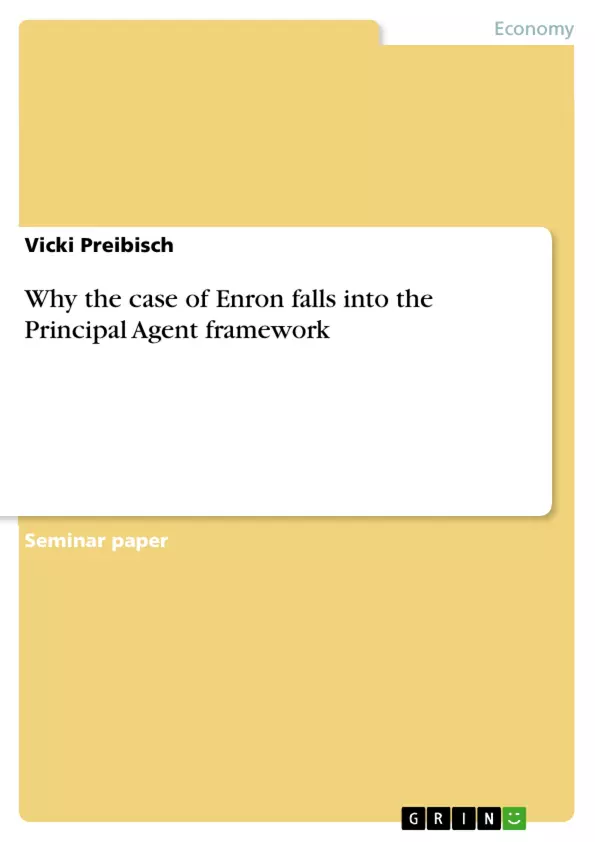It is claimed that lucrative executive compensation packages have led to irresponsible risk taking and a decline in shareholder value. This research paper is an economic approach to analyse the relationship between principals and agents, whereby the focus lies on executive remuneration incentives. The paper uses the example of Enron’s corporate failure to build a case for the principal-agent framework and analyses executive payment schemes. Aspects on the origins and possible solutions for the principal-agent relationship are looked into. The paper concludes that Enron’s compensation scheme has led to its failure.
Inhaltsverzeichnis (Table of Contents)
- Abstract
- Section I
- Introducing the Research Paper
- The P-A Theory
- Moral Hazard and Adverse Selection
- Incentive Schemes
- Section II
- Development of Executive Compensation
- 1960-1980 Growth versus Profit Development
- 1980-2000 Stock Option Boom
- 2000 - Now Is Excessive Risk Taking the Norm?
- Corporate Governance
- Development of Executive Compensation
- Section III
- Case Study: Enron and its P-A Problem
- The Role of Arthur Andersen - Cooking the Books
- Lessons Learnt
- Section IV
- P-A Theory in a Political Context
- Conclusion
Zielsetzung und Themenschwerpunkte (Objectives and Key Themes)
This research paper aims to analyze the relationship between principals and agents, specifically focusing on executive remuneration incentives and the impact of compensation schemes on corporate success. It utilizes the Enron case study to illustrate the principal-agent framework and its potential pitfalls. The paper explores the historical development of executive compensation, particularly the rise of stock options, and investigates the potential solutions to mitigate conflicts of interest between shareholders and managers.
- The Principal-Agent (P-A) Theory
- Executive Compensation and its impact on corporate performance
- The Enron Case Study as an example of P-A issues
- Historical development of executive compensation structures
- Possible solutions to mitigate conflicts of interest between shareholders and managers
Zusammenfassung der Kapitel (Chapter Summaries)
- Section I: Introducing the Research Paper This section introduces the principal-agent (P-A) theory, outlining the fundamental concepts, problems, and potential solutions. It focuses on the relationship between shareholders (principals) and managers (agents) and how conflicting interests arise due to the separation of ownership and control. This section also discusses the impact of asymmetric information on the P-A relationship, introducing the concepts of moral hazard and adverse selection.
- Section II: Development of Executive Compensation This section provides a historical analysis of executive compensation trends over the last 45 years, with a particular emphasis on the rise of stock options in the 1980s and 1990s. It explores the connection between executive pay, corporate growth, and the potential for excessive risk-taking in the context of stock option schemes.
- Section III: Case Study: Enron and its P-A Problem This section examines the Enron case study through the lens of the P-A theory. It analyses how Enron's compensation structure contributed to its downfall, highlighting the role of conflicts of interest between the company's executives and shareholders. The section also examines the role of accounting practices and corporate governance in the Enron collapse.
Schlüsselwörter (Keywords)
This research paper primarily focuses on the principal-agent theory, executive compensation, corporate governance, and corporate scandals. The paper analyzes the impact of executive remuneration incentives on corporate performance, particularly using the Enron case study to illustrate the potential consequences of misaligned interests between shareholders and managers. Key terms include: principal-agent theory, executive compensation, stock options, moral hazard, adverse selection, corporate governance, and corporate scandals.
- Citar trabajo
- Vicki Preibisch (Autor), 2006, Why the case of Enron falls into the Principal Agent framework, Múnich, GRIN Verlag, https://www.grin.com/document/67971



